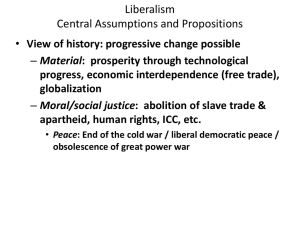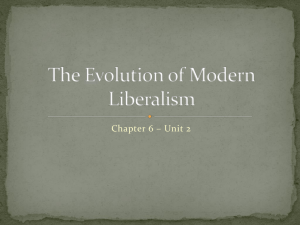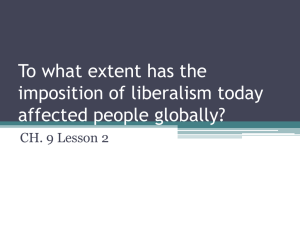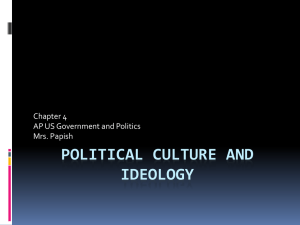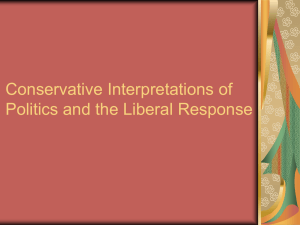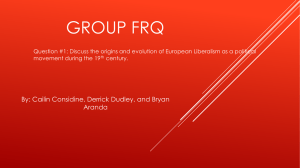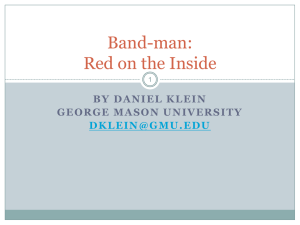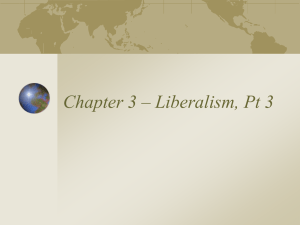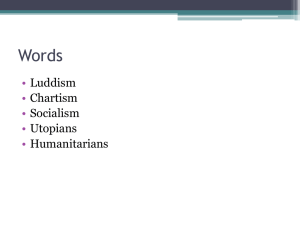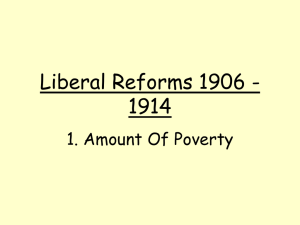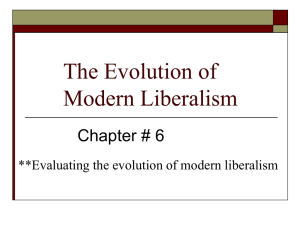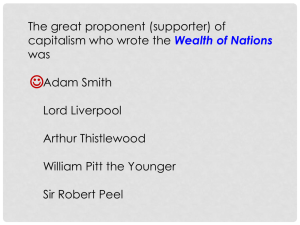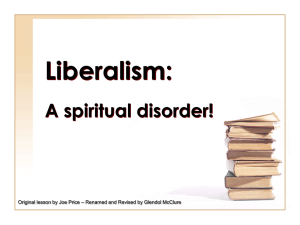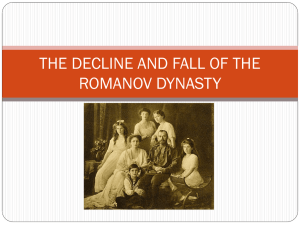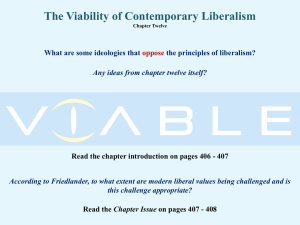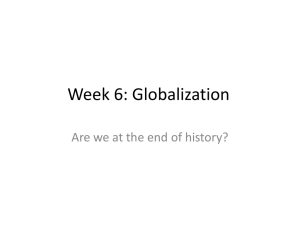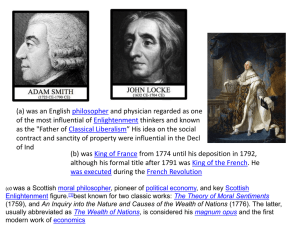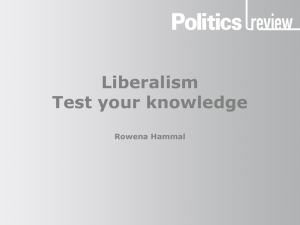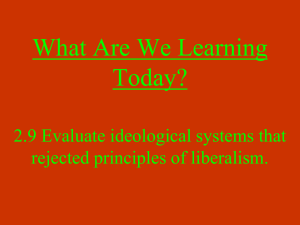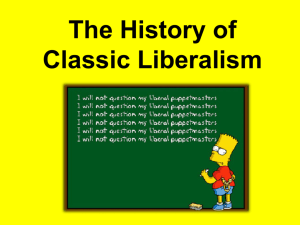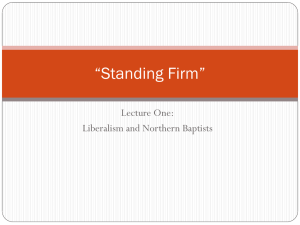Social Studies 30-1 30-2 liberalism review
advertisement
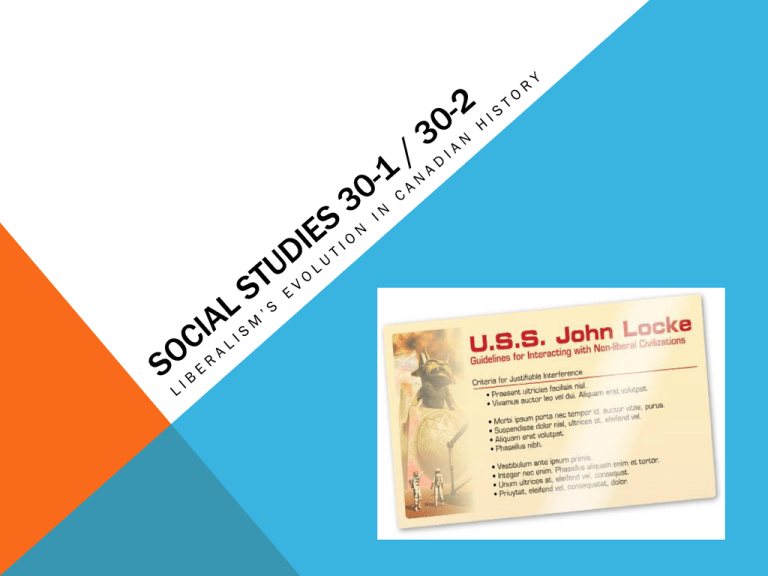
LIBERALISM Can you define it? a political orientation that favors social progress by reform and by changing laws rather than by revolution. Description: Generally liberals support ideas such as constitutionalism, liberal democracy, free and fair elections, human rights, capitalism, and the free exercise of religion. Examples in real life: Canada, The United States, The United Kingdom are all examples of Liberal Democracies HISTORY OF LIBERALISM Liberalism We can see foundations of Liberalism dating back to the Middle Ages i.e. The signing of the Magna Carta in 1215 Foundations of Liberalism were established by John Locke as he drew ideas from the Enlightenment, which questioned old traditions about societies and governments, in the 17th and 18th centuries. Locke’s contributions to liberal theory are reflected in the United States Declaration of Independence which is one of the first examples of a true Liberal Democracy. LOCKE Locke was the first to define the self through a continuity of consciousness. He postulated that the mind was a blank slate or tabula rasa. (latin) Contrary to pre-existing philosophy, he maintained that we are born without innate ideas, and that knowledge is instead determined only by experience derived from sense perception. YES NO THE MAGNA CARTA The 1215 charter required King John of England to proclaim certain liberties, and accept that his will was not arbitrary, for example by explicitly accepting that no "freeman" (in the sense of non-serf) could be punished except through the law of the land, a right which is still in existence today in England. Magna Carta was the first document forced onto an English King by a group of his subjects, the feudal barons, in an attempt to limit his powers by law and protect their privileges. It was preceded and directly influenced by the Charter of Liberties in 1100, in which King Henry I had specified particular areas wherein his powers would be limited. CLASSIC VS. MODERN LIBERALISM Classical Liberalism supports: - laissez-faire liberalism - limited government involvement - free market -capitalist society - individual property rights -individualism Modern Liberalism supports: - government involvement -cradle to grave welfare -free trade http://redstateeclectic.typepad.com/redstate_commentary/2011/02/what-is-classical-liberalism.html CANADA AND LIBERALISM Historically, Canada has had two liberal phases. Prior to the 1960s, Canadian politics were classically liberal, i.e., there was a focus on individual liberty, representative government, and free markets This brand of liberalism can be traced to the arrival in Canada of the United Empire Loyalists and the enactment of the Constitutional Act of 1791. The Constitutional Act established representative government through the elected assemblies of Upper and Lower Canada. What was the problem with the elected assembly of Upper and Lower Canada? This eventually led to the signing of the British North America Act of 1867 on July 1st 1867 What provinces originally joined confederation? CANADA AND LIBERALISM Canadians were committed to North American ideals of individual liberty and representative government. This brand of liberalism was prominent though the Liberal government of Wilfrid Laurier, which advocated such policies as free trade with the United States, and beyond. Which went against many of the ideas of John A. MacDonald during the 1870’s i.e. The National Policy and its policy of Protectionism Laurier’s dream of Free Trade would come to reality in the 1980’s thanks to Brian Mulroney. CANADA AND LIBERALISM The second liberalism began, roughly, in the 1960s with the election of Lester B. Pearson as leader of the Liberal Party of Canada and can be traced through the politics of Pierre Trudeau, Jean Chrétien, and Paul Martin. This liberalism is what is properly called in a global context social liberalism, democracy, social justice, social progressivism, Third Way, multiculturalism, diplomacy in foreign policy, and a regulated free market economy (during the Trudeau era the Liberals arguably supported a mixed economy). Canada is presently one of the more liberal countries in the Americas. By contrast, prior to the 1960s, Canada was one of the most liberal countries in the world. DIFFERENCE BETWEEN SOCIALISM AND LIBERALISM These are generalizations however most modern Social Scientists agree that: Modern Liberalism and Socialism both trace their roots to Classical Liberalism Socialists believe in the abolition of private property. Modern liberals do not. Example: As recently as the 1980s the British Labour Party included the call for the abolition of private property in its official party platform. Socialist parties elsewhere in Europe – from Spain to France to Germany and on – either still call for the abolition of private property or did so until very recently. In North American the closest the Obama Administration has come to socialism is the automotive bailout. But even that plan was initiated only because of bankruptcy in the private sector, and the ultimate goal is to release the company back to the private marketplace. It is emergency and short-term socialism. DIFFERENCE BETWEEN SOCIALISM AND LIBERALISM Most socialist states in reality have been controlled by a strong centralized government Liberalism calls for open and free elections (in theory) Is this always true? Socialism calls for major government reform and a push away from capitalism generally. Is it possible to have a socialist government working with a capitalist economy? Almost all Liberal democracies in reality have operated under a capitalist system. Does capitalism allow for individual freedoms in modern day? How has capitalism influenced Canadian politics in modern day? HOME SWEET CANADA WHICH OF THESE ARE EXAMPLES OF LIBERALISM? The Woman’s Suffrage Movement in Canada 1900’s-present day The Red and White Papers 1969 Trudeau and Chretien vs. First Nations Canadians The Charter of Rights and Freedoms 1982 The Canadian Constitution coming home 1982 Free Trade 1989 USA and Canada NAFTA 1995 Canada, Mexico, USA THE FAMOUS FIVE Emily Murphy (the British Empire's first female judge); Irene Marryat Parlby (farm women's leader, activist and first female Cabinet minister in Alberta); Nellie Mooney McClung (a suffragist and member of the Alberta legislature) Louise Crummy McKinney (the first woman elected to the Legislative Assembly of Alberta, or any legislature in Canada or the rest of the British Empire) and Henrietta Muir Edwards (an advocate for working women and a founding member of the Victorian Order of Nurses).[1] THE FAMOUS FIVE The Famous Five or The Valiant Five were five Canadian women who asked the Supreme Court of Canada to answer the question, "Does the word 'Persons' in Section 24 of the British North America Act, 1867, include female persons?" in the case Edwards v. Canada (Attorney General).[1] The petition was filed on August 27, 1927,[2] and on 24 April 1928, Canada's Supreme Court summarized its unanimous decision that women are not persons. The last line of the judgment reads, "Understood to mean 'Are women eligible for appointment to the Senate of Canada,' the question is answered in the negative." This judgment was overturned by the British Judicial Committee of the Privy Council. This case, which came to be known as the Persons Case, had important ramifications not just for women's rights but also because in overturning the case, the Judicial Committee of the Privy Council engendered a radical change in the Canadian judicial approach to the Canadian constitution, an approach that has come to be known as the "living tree doctrine". FOOD FOR THOUGHT "The Conservatives want to keep things as they are; the Socialists want to change everything; the Liberals want to change things too but not so as you'd notice; but the Communists want to go round killing people." John Bromilow, 1967 Political Scientist UK IS THIS TRUE? WHAT ARE YOUR THOUGHTS?

